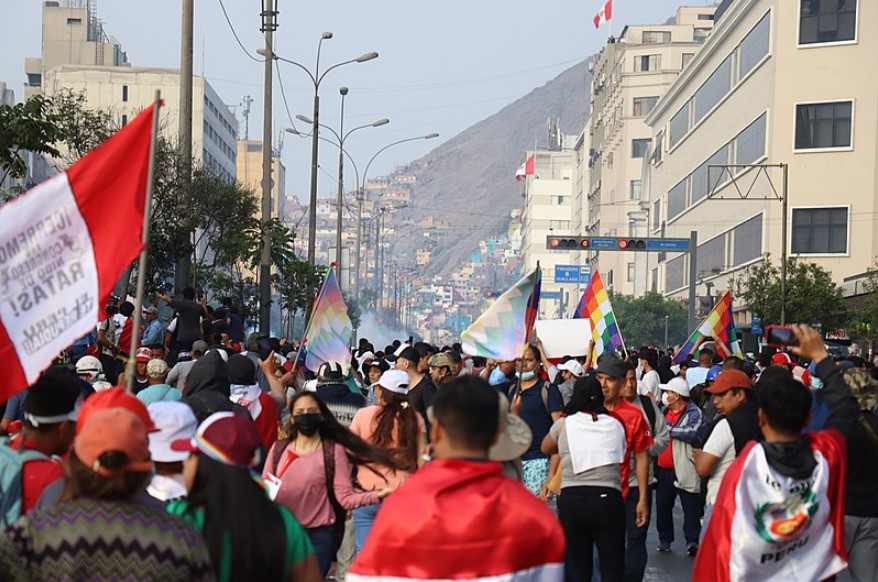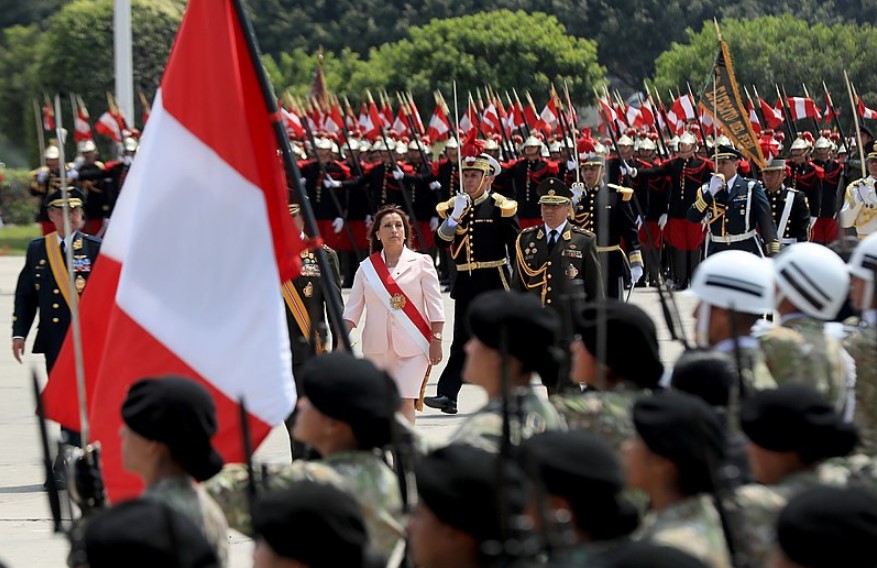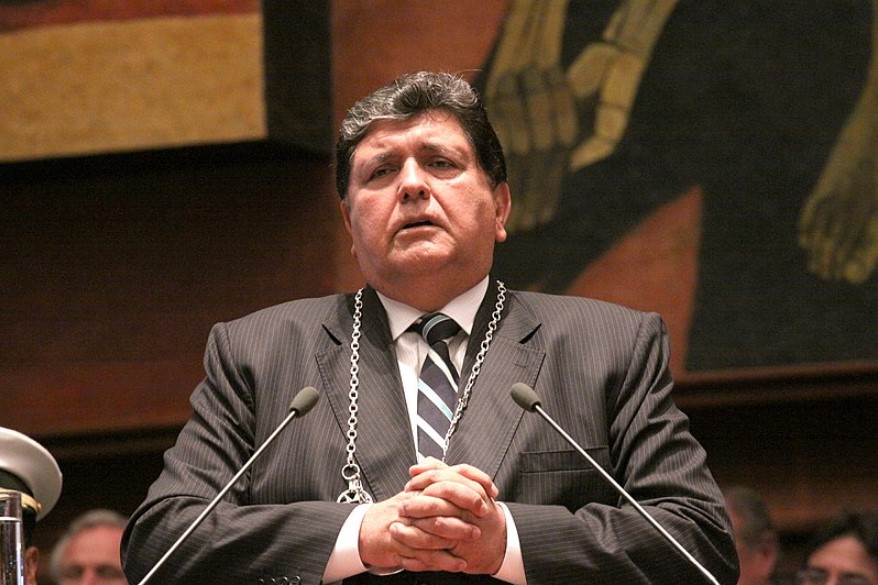
This is a crucial week for the movement against the coup in Peru. Despite brutal and continued repression, the workers, peasants and students in struggle against illegitimate president Dina Boluarte have continued fighting. The country’s trade union confederation CGTP has called for a national strike on Jan. 19 and columns of protesters are converging on the capital Lima.
Faced with growing anger and opposition, the response of the state and its institutions continues to be one of repression and criminalization of the movement. This week, 14 social and trade union leaders have been arrested. Amongst them is the General Secretary of the CGTP in the region of San Martin, in the north. The counter-terrorism branch of the Peruvian police also detained the president and seven leaders of the Ayacucho Peoples Defence Front, a mass social organization leading the movement in this Andean Department.
Police also harassed those attending a gathering of the National Peoples’ Assembly to coordinate the work towards the Jan. 19 general strike. Police surrounded the building of the Telephone Workers’ Union in Lima, where the meeting was to be held, and in a provocative way proceeded to demand ID from all those attending.
Criminalization campaign
Part of the campaign of criminalization of the movement of workers and peasants is the constant slandering of those participating as terrorists. This was particularly the case with the arrest of the leaders of the Ayacucho Peoples’ Defence Front, who were accused of being senderistas (members of the Shining Path guerrilla organization) despite the fact that this has all but disappeared. Never mind the facts, the “terrorist” nature of those arrested was splashed across all the frontpages of the daily media and broadcast widely on the TV stations.
An even wilder allegation made against the movement was that “weapons and ammunition” had been smuggled in from Bolivia and that this would explain why so many people (18) had been killed in Juliaca, Puno on Jan. 9. The facts, however, are stubborn. No actual evidence that the protesters had weapons, even less “expanding dumdum bullets” has been presented. The official forensic report for those killed is clear: nine of those killed had bullet fragments in their bodies and the others had also been killed by gunshots. All of those could be traced back to police issued AKM assault rifles (in six cases), police pellets and police handguns.
The illegitimate president Boluarte has also declared, again, a state of emergency in several provinces and departments across the country and a curfew in Puno. This means basic democratic constitutional guarantees are suspended. The declaration of the state of emergency last year, ahead of the 15 December general strike, was the prelude to massacres in which the police and the army killed at least 28 unarmed civilians, including 10 in Ayacucho in a single day.
It is the duty of the international labour movement to energetically raise its voice against this brutal repression and to reject the illegitimate coup-president Boluarte.
Marcha de los Cuatro Suyos
The tactics of the ruling class and the government are not a sign of strength but rather an indication of panic, faced with a growing movement which repression has not been able to stop.

Thousands from across the country, not only from the poor Andean regions in the south, but also from the north, are making their way to the capital Lima with one aim: to bring down the hated, bloodstained Dina Boluarte. The movement has become known as the “Marcha de los Cuatro Suyos” (march from the four corners), after the massive march on Lima in 2000, which finally brought down the dictatorship of Fujimori.
Workers, peasants, students in towns and cities have organized collections of money and food to sustain delegations to the capital. They are coming from the Aymara-speaking regions, from the rondas campesinas (peasant patrols) north of Lima, from Ayacucho, from the jungle regions in the east, etc. Police roadblocks are stopping some of the caravans, but the people are finding ways to get through.
The movement has widespread popular support, from which it derives its strength. According to a recent opinion poll by IEP, 60 per cent of the population think that the protests are justified (72 per cent amongst the youth) and 58 percent think that the police and army committed excesses (70 per cent amongst the youth). On the other hand, 71 per cent disapprove of Dina Boluarte’s presidency, with a mere 19 per cent in favour. Congress is even more discredited with a record 89 per cent against. An overwhelming 69 per cent of the population now think there should be a Constituent Assembly, up 22 points since a year ago, an indication of widespread rejection of all existing bourgeois institutions.
The government of Boluarte is against the ropes, with even some institutions coming out openly against her, and several regional governors demanding her resignation, with even some of her own ministers tending their resignation. The march on Lima and the general strike could be the last blow, which forces the ignominious collapse of this illegitimate president.
“Never again poor people in a rich country”
The mass movement of workers and peasants has grown in strength and acquired a certain degree of national coordination. Its political program so far is limited to democratic demands: freedom for Castillo, closing down of congress, new elections and a constituent assembly. But what lies behind these demands is a deep seated desire for fundamental change, one which is not limited to just political questions, as important as they are, but which is based on a desire for a general improvement of living standards and a substantial redistribution of wealth.

Castillo’s election slogan “never again poor people in a rich country” encapsulates what’s behind this mass movement. Peru is indeed a wealthy country, but one where power and resources are in hands of a handful of parasitical economic groups, national and multinational, while the majority of the people live in poverty conditions.
It is significant that the movement is making reference to the march of the Cuatro Suyos in 2000 and also raising the slogan of “todas las sangres” (meaning all the different ethnic and national groups which make up the country). The idea is that the workers and peasants of Peru, united as a single fighting unit, converging on the capital, can bring down the government. That is correct.
However, what happened after the overthrow of Fujimori in 2000 was the coming to power of self-styled social democrat Alan Garcia, who then proceeded to continue the ultra-liberal capitalist economic policies of his predecessor. The peoples’ victory was transformed into disillusionment as the mining multinationals and 17 Peruvian economic conglomerates continued to loot the country’s wealth, bribing presidents and state officials in the process.
This time, the issue must be posed point blank. For there to the real meaningful change, for which nearly 50 have already given their lives in the last 40 days, the masses must brush aside not only the rotten institutions of bourgeois power but also expropriate the capitalist oligarchy and the multinationals, so that the country’s wealth can be democratically planned, under workers’ control, in the benefit of the majority. That is the only prize worthy of the blood that has been shed in this struggle.
Victory to the Peruvian workers and peasants!
Down with Dina Boluarte! Close down Congress! Kick them all out!
Expropriate the capitalist oligarchy and the mining multinational!
All power to the working people!

